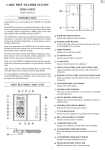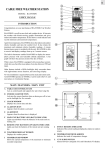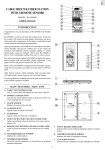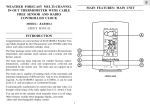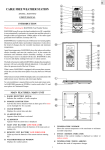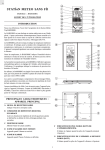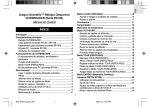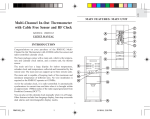Download Oregon Scientific BAR928 User's Manual
Transcript
Cable Free Weather Station Model: BAR928 User Manual BAR928-E Cover R1 OP 1 Black 8/21/04, 11:55 PM EN CABLE FREE WEATHER STATION MODEL: BAR928 USER’S MANUAL INTRODUCTION Congratulations on purchasing the BAR928 Top Weather Station. The BAR928 is an all-in-one clock and weather device. RF- controlled, it can automatically synchronize its current time and date when it is brought within an approximate 1500km radius of the radio signal generated from Frankfurt, Germany (DCF77). The BAR928 does weather forecasts and tells temperatures, indoors and outdoors. It also shows the trend of changes plus the recorded maximum and minimum temperatures. A remote thermo sensor is included with the unit. A RADIO RECEPTION SIGNAL Indicates the condition of radio reception B SNOOZE/LIGHT BUTTON Activates the snooze function when an alarm goes off or turn on the backlight for five seconds Apart from temperature, the BAR928 shows the indoor relative humidity and rates the comfort level. It also retains the maximum and minimum relative humidity readings. C MODE WINDOW The built-in barometer enables the BAR928 to display the atmospheric pressure with user-selectable altitude adjustment. A bar graph will show the pressure trend of the last 24 hours. Displays the current time and date D ALARM ON ICON Appears when the alarm is activated What is more, the BAR928 is equipped with a moon phase scanner, which lets you check the moon phase of any day between 1990 and 2089. E ALARM ICON Other features include a HiGlo backlight, daily crescendo alarm with eight-minute snooze function, and extra-large display. F MAIN UNIT BATTERY LOW (BATT) INDICATOR Appears when the alarm time is displayed Lights up and blinks when the batteries of the main unit are running dry No wire installation is required between the main and remote units. As the BAR928 operates at 433MHz, it can be used in the U.S. and most places in Continental Europe. G REMOTE UNIT BATTERY LOW (BATT) INDICATOR Lights up and blinks when the batteries of the remote unit are running dry MAIN FEATURES: MAIN UNIT H WEATHER FORECAST WINDOW Displays the weather pattern I TEMPERATURE WINDOW Shows the current temperature or the maximum or minimum recorded temperature J IN/OUT-REMOTE INDICATOR Indicates if the current temperature is displayed as indoors or outdoor-remote K TEMPERATURE TREND ARROWS Indicates the trend of temperature changes L °C/°F SLIDE SWITCH Selects between Centigrade (°C) and Fahrenheit (°F) display M RELATIVE HUMIDITY WINDOW Displays the indoor relative humidity N COMFORT INDICATOR Indicates the comfort level of the indoor relative humidity O ATMOSPHERIC PRESSURE CHART Shows the atmospheric pressure trend chart of the last 24 hours P ATMOSPHERIC PRESSURE WINDOW Displays the current atmospheric pressure Q PRESSURE HISTORY INDICATOR Indicates the pressure history of previous hours 1 BAR928-E R1 OP 1 8/21/04, 11:54 PM EN H PRESSURE UNIT SLIDE SWITCH A LCD Selects between mb/hPa and inHg display Displays the current temperature monitored by the remote unit S MOON PHASE SCANNER B LED INDICATOR Displays the current moon phase or that of the date checked T U V W Flashes when the remote unit transmits a reading THERMO BUTTON Sets the unit in indoor or outdoor-remote temperature mode C °C/°F SLIDE SWITCH Selects between Centigrade (°C) and Fahrenheit (°F) MEMORY BUTTON Displays the maximum or minimum temperature or indoor relative humidity or erases the memory D RESET BUTTON Returns all settings to default values HISTORY BUTTON Displays the pressure history of previous hours E BATTERY COMPARTMENT UP ( ) AND DOWN ( ) BUTTONS Increases or decreases the value of a setting, scan the moonphase status F WALL-MOUNT HOLDER X ALARM ON/OFF BUTTON Displays the alarm time or sets the alarm status Y MODE BUTTON Changes the display mode of the clock or triggers the clock setting mode Z RESET BUTTON Resets the unit by returning all settings to their default values AA BATTERY COMPARTMENT Accommodates four UM3 or AA-size batteries AB TABLE AND CONTROL STAND Acts as control panel and supports the unit when lying flat. Accommodates two UM4 or AAA-size batteries Supports the remote unit in wall-mounting G REMOVABLE TABLE STAND For standing the remote unit on a flat surface BEFORE YOU BEGIN For best operation, 1. Insert batteries for remote units before doing so for the main unit. 2. Position the remote unit and main unit within effective transmission range, which, in usual circumstances, is 30 meters. Though the remote unit is weather proof, it should be placed away from direct sunlight, rain or snow. BATTERY INSTALLATION: REMOTE UNIT MAIN FEATURES: REMOTE UNIT The remote unit uses two UM4 or AAA-size batteries. To install them, 1. Remove the screws on the battery compartment. 2. Insert the batteries strictly according to the polarities shown therein. 3. Select the temperature display unit on the °C/°F slide switch. 4. Replace the battery compartment door and secure its screws. Replace the batteries when the battery low (BATT) indicator of the outdoor temperature window lights up. 2 BAR928-E R1 OP 2 8/21/04, 11:54 PM EN BATTERY INSTALLATION: MAIN UNIT - Strong 1. Gently press and lift the tab on the battery compartment door. 2. Insert four UM3 or AA-size batteries. - Weak - No signal - Receiving 3. Replace the battery compartment door. Replace the batteries when the BATT indicator on the weather forecast window lights up. HOW TO SET THE CLOCK MANUALLY When the current time is displayed, press MODE for three seconds. The 12-hr or 24-hr digits will flash. Use the UP or DOWN button to select either. If 12-hour clock format is selected, the time will be displayed with the AM or PM indicator. HOW TO USE THE BACKLIGHT Press the SNOOZE/LIGHT button once. The backlight will be turned on for five seconds. Press MODE. The hour digits will flash. Use the UP or DOWN buttons to enter the hours. Holding down either button will increase or decrease the value rapidly. Press MODE to go to the minutes. Set the minutes like you set the hours. Press MODE again to confirm and exit. TIME DISPLAY MODES The current time and date can be displayed in three modes: hourminute-second, hour-minute-day-of-the-week and day-month-year. Press the MODE button to change from one mode to the other. If changes are made during this process, the seconds will start from zeros. ABOUT ALTITUDE SETTING For a correct reading of the local barometric pressure, select 0 for altitude compensation reading while setting the calendar. (See HOW TO SET THE CALENDAR for details.) Pressing the ALARM button during any of these modes will display the alarm time instead. Another press will activate or deactivate the alarm. To go back to normal time and date display, press MODE. For users staying at a higher altitude, such as in the mountain area, sea level barometric pressure applies. In this case, select -100 to 2500 meters, whichever appropriate, when entering the altitude compensation reading. ABOUT RADIO RECEPTION The BAR928 is designed to automatically synchronize its calendar clock once it is brought within range of the Frankfurt DCF77 radio signal. It will scan and adjust every full hour. HOW TO SET THE CALENDAR MANUALLY When the BAR928 is within range, its radio-control mechanism will override all manual settings. • When the calendar is displayed, press MODE for three seconds. When the unit is receiving radio signal, the RADIO RECEPTION signal will start to blink. A complete reception generally takes about two to 10 minutes, depending on the strength of the radio signal. The altitude compensation reading on the atmospheric pressure window will flash. Use the UP or DOWN button to enter the desired value. (See ABOUT ALTITUDE SETTING for more information.) When the reception is complete, the RADIO RECEPTION signal will stop blinking. The strength of the reception for the last full hour will be indicated. • Press MODE. The year digits will flash. Enter the year using the UP or DOWN button. • Press MODE. The D or M indicator will flash. Use the UP or For better reception, place the clock away from metal objects and electrical appliances to minimize interference. DOWN button to select D for day-month display or M for month-day display. Should you wish to deactivate the RF controlled function, press MODE and DOWN( ) button simultaneously. • Press MODE and follow the same procedure to set the month and day-of-the-month. To reactivate the RF control function, press MODE and UP( simultaneously. ) • Press MODE. The E, I, D, F or S language indicator will flash. Use the UP or DOWN button to select E for English, I for Italian, D for German, F for French or S for Spanish. • Press MODE. The day-of-the-week will flash. Use the UP or DOWN button to enter the day and press MODE again to confirm and exit. 3 BAR928-E R1 OP 3 8/21/04, 11:54 PM EN MULTILINGUAL DAY-OF-THE-WEEK NOTE ON OUTDOOR-REMOTE TEMPERATURE The display language of the day-of-the-week is selected in the calendar setting procedure. The foreign languages and their meanings are as follows: Language Monday Tuesday Wednesday Thursday Friday Saturday Once batteries are in place for the remote unit, it will start transmitting samplings at 30-second intervals. If no signals are received when the outdoor-remote temperature is selected, blanks will be displayed. Press and hold the THERMO button to enforce a search. This is useful in synchronizing the transmission and reception of the remote and main units. Sunday English German If that fails, check if the remote unit is still in place. Make sure the transmission is within range and path is clear of obstacles and interference. French Italian Repeat this procedure whenever you find discrepancies between the reading shown on the main unit and the remote unit. Spanish NOTE ON °C AND °F HOW TO SET AND ACTIVATE THE ALARM The outdoor temperature display on the main unit is dominated by the selection on the °C/°F slide switch of the main unit. Whatever the display unit of the remote sensor is, it will only apply to the remote sensor itself and the temperature will be automatically converted to the chosen one of the main unit. When the alarm time is displayed, press and hold ALARM for three seconds. Enter the value for the hour digits. Press ALARM to confirm and go to the minute digits. Enter the value and press ALARM to confirm. MAXIMUM AND MINIMUM TEMPERATURES The alarm is automatically activated. To deactivate it, press ALARM once when the alarm time is displayed. Then use the UP or DOWN button to toggle its status. The maximum and minimum recorded temperatures will be automatically stored in memory. To display them, press MEMORY to rotate through the maximum, minimum and current temperatures. The respective MAX or MIN indicator will be displayed. ALARM AND SNOOZE FUNCTION When the alarm is active, it will go off at the set time. The display will light up for five seconds with the ALARM ON icon flashing. To clear the memory, hold down MEMORY for three seconds. The maximum and minimum temperatures will be erased. If you press MEMORY now, the maximum and minimum temperatures will have the same values as the current one until different readings are recorded. The crescendo function allows the alarm to start off gently and step up its intensity in three steps. Without interruption, the alarm will go off for 2 minute. To stop the alarm, press any button. If the SNOOZE/LIGHT button is pressed, the SNOOZE function will be triggered. The alarm will stop and the bell icon blinks for about eight minutes before going off again. TEMPERATURE TREND The temperature trend indicator shows the trend of temperature changes for the last minutes. Three trends, rising, steady and falling, will be shown. HOW TO CHECK INDOOR AND OUTDOOR-REMOTE TEMPERATURES Arrow indicator To measure indoor temperatures, press the THERMO button until the IN indicator lights up. Temperature Trend To measure outdoor-remote temperatures, press the THERMO button until the OUT indicator is displayed. The temperature can be shown in Centigrade (°C) or Fahrenheit (°F). It is selected on the °C/°F slide switch. Slide the switch to °C for Centigrade or °F for Fahrenheit. Rising Steady Falling WEATHER FORECAST The unit is capable of detecting atmospheric pressure changes, and basing on the data collected, can predict the weather for the forthcoming 12 to 24 hours. The effective range covers an area of 30 to 50 km. The BAR928 is capable of measuring temperatures within the -50°C (-58°F) and +70°C (+158°F) range. If the temperature goes above or below that, the display will show flashing ”70” or “-50”. Indicator displays on the unit Forecast Sunny Slightly Cloudy 4 BAR928-E R1 OP 4 8/21/04, 11:54 PM Cloudy Rainy EN NOTE: HOW TO USE AND SCAN THE MOON PHASE 1. The accuracy of a general pressure-based weather forecast is about 70 to 75%, and therefore, cannot be held responsible for any inconveniences so caused by an inaccurate forecast. The BAR928 is equipped with a moon phase display and scanner with which eight moon phases are displayed on the screen from new moon to waning crescent. The one falls on the current day will flash on the screen. 2. The weather forecast is meant for the next 12 to 24 hours. It may not necessarily reflect the current situation. 3. The “Sunny” icon, when applies to night time, implies clear weather. If it is a full moon or new moon day, the icon will flash faster. The eight phases are: INDOOR RELATIVE HUMIDITY The indoor relative humidity is automatically detected. The reading is displayed in the relative humidity window. Like temperature, the maximum and minimum relative humidity will be stored in memory. Use the MEMORY button to rotate through the maximum, minimum and current relative humidity. The respective MAX and MIN indicator will be displayed. New Moon Waning Crescent Waxing Crescent Last Quarter First Quarter To clear the memory, hold down MEMORY for three seconds. The maximum and minimum temperatures will be erased. If you press MEMORY now, the maximum and minimum relative humidity will have the same values as the current one until different readings are recorded. Waning Gibbous Waxing Gibbous Full Moon To check the moon phase for a particular day, press the UP or DOWN button once. The clock will enter moon phase scanning mode. COMFORT LEVEL Use the UP or DOWN button to locate the date you want to check. The calendar will be day-driven in this mode. The comfort level is based on the recorded relative humidity. An indicator will be displayed to show if the level is comfortable, wet or dry. You can go back in time or travel to the future, any day between the years 1990 to 2089. The corresponding moon phase will appear immediately on the screen. The unit will return to the last display mode when the UP and DOWN buttons are left idle for 15 seconds. ATMOSPHERIC PRESSURE HOW TO WALL MOUNT OR USE THE TABLE STAND The current atmospheric pressure is shown on the atmospheric pressure window. If you need to adjust the altitude compensation, follow the procedure set in HOW TO SET THE CALENDAR MANUALLY. The unit can be wall-mounted using its recessed screw holes or place on a flat surface using its table and control stand. To use the stand, lay the control panel on a flat surface. Then adjust the angle of the display panel for best display and support. The atmospheric pressure can be displayed in mb/hPa or inHg. The unit is selected on the atmospheric pressure slide switch. Wall-mount If you want to know the pressure history for a particular hour during the past 24 hours, press the HISTORY button. Each press on the button will go back by an hour. Holding down the button will increase the value rapidly. The recorded atmospheric changes for the past 24 hours are displayed in a bar chart above the atmospheric pressure window. Table stand 5 BAR928-E R1 OP 5 8/21/04, 11:54 PM EN Temperature resolution HOW TO RESET THE UNIT : 0.1°C (0.2°F) Remote Temperature measurement The RESET button allows you to return all settings to its factory values. The button is required only when the unit is not operating in a favorable way, such as in the rare case of a malfunction. Displayed OUT temperature range : -50.0°C to +70.0°C (-58.0°F to 158.0°F) The RESET button is located inside the battery compartment door. To use the button, Proposed operating range : -5.0°C to +50.0°C (23.0°F to 122.0°F) 1. Lift open the battery compartment door. Temperature resolution : 0.1°C (0.2°F) 2. Press the button with a blunt stylus. Remote unit 3. Replace the battery compartment door. Displayed range : -50.0°C to +70.0°C (-58.0°F to 158.0°F) Proposed operating range : -20.0°C to +60.0°C (-4.0°F to 140.0°F) Temperature resolution : 0.1°C (0.2°F) PRECAUTIONS This unit is engineered to give you years of satisfactory service if you handle it carefully. Here are a few precautions: 1. Do not immerse the unit in water. If you spill liquid over it, dry it immediately with a soft, lint-free cloth. RF Transmission Frequency : 433 MHz No. of Remote unit : one 2. Do not clean the unit with abrasive or corrosive materials. They may scratch the plastic parts and corrode the electronic circuit. RF Transmission Range : Maximum 30 meters Temperature sensing cycle : around 30 seconds 3. Do not subject the unit to excessive force, shock, dust, temperature or humidity, which may result in malfunction, shorter electronic life span, damaged battery and distorted parts. • Relative Humidity Measurement Indoor relative humidity measurement ranging from 25%RH to 95%RH 4. Do not tamper with the unit’s internal components. Doing so will invalidate the warranty on the unit and may cause unnecessary damage. The unit contains no user-serviceable parts. • Barometric Pressure Measurement 5. Only use fresh batteries as specified in the user’s instructions. Do not mix new and old batteries as the old ones may leak. 6. Always read the user’s instructions thoroughly before operating the unit. Pressure measuring range : 795 to 1050 mb/ hPa (23.48 to 31.01 inHg) Pressure sampling cycle : 15 minutes • Moon Phase Functions TIME ZONE AND OFFSET TABLE Moon Phase Scanner Range : From 1990 to 2089 • Radio Controlled Clock - Maintime set and synchronized by Radio Signal DCF77 for Continental/ Central Europe - user selectable 12 or 24h display with hh : mm ss - Date Format : Day-Month-Year or Month-Day-Year - Day of week selectable in 5 language (E, F, D, I, Sp ) - 2-minute crescendo alarm • Power Main unit : use 4 pcs UM-3 or “AA” 1.5V alkaline batteries Remote sensing unit : use 2 pcs UM-4 or “AAA” 1.5V alkaline batteries SPECIFICATIONS • Temperature Measurement • Weight Main unit Main unit Remote sensing unit Indoor Temperature measurement Displayed IN temperature range : -50.0°C to +70.0°C (-58.0°F to 158.0°F) Proposed operating range • Dimension : -5.0°C to +50.0°C (23.0°F to 122.0°F) 6 BAR928-E R1 OP 6 : 306 gm : 100 gm Main unit : 182(L) x 133(W) x 28(T) mm Remote sensing unit : 92(L) x 60(W) x 21(T) mm 8/21/04, 11:54 PM EN CAUTION EC-DECLARATION OF CONFORMITY — The content of this manual is subject to change without further notice. This product contains the approved transmitter module that complies with the essential requirements of Article 3 of the R&TTE 1999 / 5 / EC Directive, if used as intended and the following standards have been applied: — Due to printing limitations, the displays shown in this manual may differ from the actual display. — The manufacturer and its suppliers hold no responsibility to you or any other person for any damage expenses, lost profits, or any other claim as a result of using this product. Safety of information technology equipment (Article 3.1.a of the R&TTE Directive) Applied Standard EN 60950-1 : 2001 — The contents of this manual may not be reproduced without the permission of the manufacturer. Electromagnetic compatibility (Article 3.1.b of the R&TTE Directive) Applied Standards ETSI EN 301 489-1-3 (Ver.1.4.1) : 2002-08 ABOUT OREGON SCIENTIFIC Visit our website (www.oregonscientific.com) to learn more about Oregon Scientific products such as digital cameras; MP3 players; children's electronic learning products and games; projection clocks; health and fitness gear; weather stations; and digital and conference phones. The website also includes contact information for our customer care department in case you need to reach us, as well as frequently asked questions and customer downloads. Efficient use of radio frequency spectrum (Article 3.2 of the R&TTE Directive) Applied Standards ETSI EN 300 220-3 (Ver1.1.1) : 2000-09 Additional information: We hope you will find all the information you need on our website, however if you'd like to contact the Oregon Scientific Customer Care department directly, please visit: www2.oregonscientific.com/ service/support The product herewith complies with the requirements of the Low Voltage Directive 73 / 23 / EC, the EMC Directive 89 / 336 / EC and carries the CE marking accordingly. OR Call 949-608-2848 in the US. Carmelo Cubito Agrate Brianza (MI) / Italy January 2004 For international enquiries, please visit www2.oregonscientific.com/ about/international/default.asp Manufacturer's EU R&TTE Representative COUNTRIES RTTE APPROVAL COMPLIED All EC countries, Switzerland and Norway 7 BAR928-E R1 OP 7 8/21/04, 11:54 PM CH N © 2004 Oregon Scientific. All Rights Reserved. 086-001853-226 BAR928-E Back R1 OP 1 Black 8/21/04, 11:55 PM









